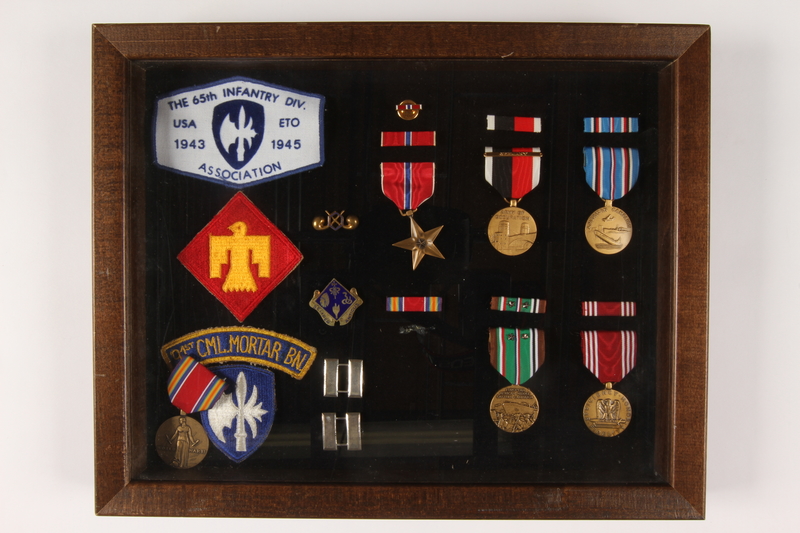Overview
- Brief Narrative
- Decorative shadow box containing military awards, patches and insignia issued to and received by J. George Mitnick by the United States Army for his service in World War II. The box includes insignia from the 65th and 45th infantry divisions, and the 91st Chemical Mortar Battalion, along with a Bronze Star, a World War II victory medal, Army of Occupation Medal, European–African–Middle Eastern Campaign Medal, an American Campaign medal, and a Good Conduct medal. Mitnick, a 27-year-old Jewish American, served as a captain in the 65th Infantry Division, and in the Chemical Warfare Service, 91st Chemical Mortar Battalion, 45th Infantry Division in the European Theater. His unit took control of the Ohrdruf concentration camp in April 1945; nearly all the inhabitants were dead, killed by the departing German troops. This was the first concentration camp liberated by US troops and descriptions of the conditions horrified the world. Mitnick’s unit continued on into Austria and was involved with the liberation of Mauthausen concentration camp. Captain Mitnick was awarded two Bronze Stars for his service.
- Date
-
received:
1941 December 07
- Credit Line
- United States Holocaust Memorial Museum Collection, Gift of Ronne Mitnick Hess
- Markings
- front, upper left patch, machine stitched, blue thread : THE 65th INFANTRY DIV. / USA / 1943 / ETO / 1945 / ASSOCIATION
front, bottom left patch, machine stitched, yellow thread : 91st CML.MORTAR BN.
front, center badge, printed, blue ink : SEMPER / ANTICUS [always forward]
front, bottom center badge, embossed : WORLD WAR II / TJ
front, upper right medal, embossed : ARMY OF OCCUPATION
front, lower right medal, embossed : EUROPEAN / AFRICAN MIDDLE / EASTERN CAMAIGN
front, top right medal, embossed : AMERICAN CAMPAIGN
front, bottom right medal, embossed : EFFICIENCY HONOR FIDELITY - Contributor
-
Subject:
J. George Mitnick
Issuer: United States. Army
- Biography
-
J. George Mitnick (1917-2005) was born in Hartford Connecticut to David and Rose Mitnick (nee Schwartz). George was the youngest of six children and was raised in a conservative religious home. After high school, George attended the University of Connecticut. Due to family financial stress, George left school after two years and got a job at a supermarket. After a year, he began working at the lumber company owned by his father and two uncles. After Japan bombed Pearl Harbor on December 7, 1941, George enlisted in the Army.
George trained at camp Devens, Massachusetts, and Camp Lee, Virginia before entering Officer Candidate School (OCS) in Edgeward, Maryland. George graduated as a Second Lieutenant in the 45th Infantry Division and was sent to Gadsden and then to Fort McClellan, Alabama for further training. While he was stationed in Alabama, George was promoted to Captain. He also met Willine Engel while visiting Birmingham, and the two began a relationship. George then received orders to report to the headquarters of the 65th Infantry Division at Camp Shelby, Mississippi. While in Shelby, George and Willine were married in spring 1944, and then George shipped out to Europe with the 65th.
The 65th landed at Le Havre, France in January, 1945, and was deployed to the German border in March. In April, the division advanced into Bavaria and captured the city of Regensburg. On April 13, George arrived at the recently liberated Ohrdruf concentration camp in Germany. There he saw the abysmal living conditions and the sickly, emaciated corpses of the prisoners the guards killed before they fled. On April 20, the division liberated a subcamp in the Flossenbürg camp system. In May, the 65th captured the town of Passau, then moved into Austria and captured the city of Linz. On May 9, hostilities officially ended in Europe, George was among the troops of the 65th who made contact with the Russians at Erlauf. After the war, George was assigned to arrange for the separation of displaced persons to allow transfer to their homelands.
After George returned home, he and Willene settled in Jasper, Alabama and had two daughters. In 1948 George and his brother-in-law, Joe, opened a dry goods store. Over the next eight years, they expanded to nine stores. Then in 1956, they converted the stores to dollar stores with the new name, Top Dollar Stores. George and Joe were able to expand into a chain of over 230 stores in 11 states before the chain was sold to the Sav-A-Stop company. George was very active in professional, civic, and philanthropic organizations. He founded the Walker Area Community Foundation, along with the Walker College Civic Concert Association, and he and his wife established the Mitnick Fellowship Fund to help young adults in Alabama. George was President of Temple Emanu-El, in Jasper, as well as a past president of Walker County Lodge of B'nai B'rith and he was a Member of the Executive Board of the American Israel Public Affairs Committee (AIPAC), which named him "Man of the Year" in 2003.
Physical Details
- Language
- English
- Classification
-
Military Insignia
- Category
-
Medals
- Object Type
-
Medals--United States (lcsh)
- Genre/Form
- Military decorations.
- Physical Description
- Rectangular, glass enclosed, wood framed shadow box with US Army insignia, patches, and medals mounted in five columns on a black fabric background. The first column on the left displays a white and blue rectangular 65th infantry patch; a shoulder sleeve insignia of the 45th infantry division featuring a gold thunderbird on a red field; a rectangular, curved shoulder patch for the 91st Chemical Mortar Battalion; and a 65th infantry shield shaped shoulder patch with a white halberd on a blue field. The next column exhibits the branch insignia of the Chemical Corps (mounted upside down), the blue and gold 1920-1946 distinctive unit insignia of the 45th Infantry Division, and two silver colored captains’ insignia. The next column contains a Bronze Star lapel pin, ribbon bar and medal, and a World War II Victory Medal ribbon bar and medal. The next column presents an Army of Occupation Medal ribbon bar and medal, in addition to a European–African–Middle Eastern Campaign Medal ribbon bar and medal, both with two Service Stars. The final column contains an American Campaign Medal ribbon bar and medal, and a Good Conduct Medal ribbon bar and medal. The back of the shadow box is covered in brown paper, and near the top is a metal wire strung through two eye hooks which are screwed into the frame. A metallic, gold sticker with the contact information of the maker of the shadow box is in the bottom center.
- Dimensions
- overall: Height: 12.250 inches (31.115 cm) | Width: 15.250 inches (38.735 cm) | Depth: 2.250 inches (5.715 cm)
- Materials
- overall : wood, glass, paper, metal, cloth, adhesive
Rights & Restrictions
- Conditions on Access
- No restrictions on access
- Conditions on Use
- No restrictions on use
Keywords & Subjects
- Topical Term
- Soldiers--United States--Biography. Jewish soldiers--United States--Biography. World War, 1939-1945--Concentration camps--Liberation--Personal narratives, American. World War, 1939-1945--Personal narratives, American. United States. Army--Insignia. United States. Army--Officers. United States. Army--Awards. Souvenirs (Keepsakes)--Soldiers--United States--Biography.
Administrative Notes
- Legal Status
- Permanent Collection
- Provenance
- The shadow box was donated to the United States Holocaust Memorial Museum in 2014 by Ronne Mitnick Hess, the daughter of J. George Mitnick.
- Record last modified:
- 2023-08-25 16:39:36
- This page:
- https://collections.ushmm.org/search/catalog/irn531620
Download & Licensing
In-Person Research
- By Appointment
- Request 21 Days in Advance of Visit
- Plan a Research Visit
- Request to See This Object
Contact Us
Also in J. George Mitnick collection
The collection consists of artifacts, documents, and photographs relating to the experience of J. George Mitnick before and during his tour of duty as a Captain in the US Army, 65th Infantry Division, in Europe where his unit liberated Ohrdruf concentration camp in Germany and assisted in the liberation of Mauthausen concentration camp in Austria and after the war in the United States.
Date: 1943-2005
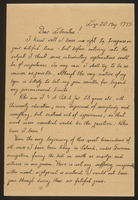
J. George Mitnick papers
Document
The J. George Mitnick papers consist of biographical material, correspondence, military records, photographs, and printed materials documenting American serviceman J. George Mitnick, his World War II military service, and the horrors he witnessed at the liberated Ohrdruf concentration camp. Biographical materials include a biographical statement and memoir describing Mitnick’s life and military service, a tribute to Mitnick by Senator Shelby, and an interview with and biography of Rabbi Hugo Gryn who was liberated from Mauthausen by Mitnick’s unit. Correspondence primarily consists of letters Mitnick wrote to his parents during his World War II military service. One letter dated April 13, 1945 describes the horrors he witnessed at the liberated Ohrdruf concentration camp. Another letter written in May 1945 at the Linz Displaced Persons camp by Julius Levy, a Polish Jew who addresses his letter to his liberators, describes having lost everything in the Holocaust, and begging to be transferred to an Allied hospital to recover. This series also includes correspondence among Mitnick, his wife, and her mother. Military records document Mitnick’s service in World War II. They primarily consist of Mitnick’s military personnel file from 1942 through the 1950s including orders, commendations, veteran materials, and transactional correspondence. This series also includes Mitnick’s Army Officer’s Notebook containing his notes as well as form letters and blank forms. Loose photographs depict Mitnick in uniform and members of the Engel family. A photo album titled “Astra Breifmarken Album” includes additional photographs of Mitnick in military uniform while training in the US and on leave in Europe and of his wife and their family and friends. This series also includes two empty scrapbooks and an empty portfolio. Printed material includes a pamphlet titled The Halberd about a 1951 reunion of the 65th Division, two 1940s Mountain Eagle clipping about Mitnick, a 1994 Palm Beach Post clipping about Patton’s assault on Saarbrucken, and a 1945 issued of The Hartford Times that Mitnick used to line his army footlocker.
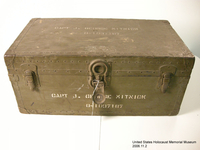
US Army footlocker used by a soldier
Object
Footlocker used by J. George Mitnick during World War II. Mitnick, a 27 year-old Jewish American, served as a captain in the 65th Infantry Division, European Theater. His unit took control of the Ohrdruf concentration camp in April 1945; nearly all the inhabitants were dead, killed by the departing German troops. This was the first concentration camp liberated by US troops and descriptions of the conditions horrified the world. Mitnick’s unit continued on into Austria and was involved with the liberation of Mauthausen concentration camp. Captain Mitnick was awarded two Bronze Stars for his service.
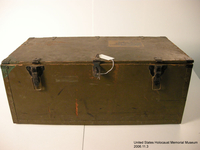
US Army footlocker used by a soldier
Object
Footlocker issued to J. George Mitnick by the United States Army during World War II. Mitnick, a 27 year-old Jewish American, served as a captain in the 65th Infantry Division, European Theater. His unit took control of the Ohrdruf concentration camp in April 1945; nearly all the inhabitants were dead, killed by the departing German troops. This was the first concentration camp liberated by US troops and descriptions of the conditions horrified the world. Mitnick’s unit continued on into Austria and was involved with the liberation of Mauthausen concentration camp. Captain Mitnick was awarded two Bronze Stars for his service.
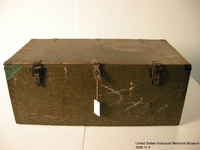
US Army footlocker used by a soldier
Object
Footlocker issued to J. George Mitnick by the United States Army during World War II. Mitnick, a 27 year-old Jewish American, served as a captain in the 65th Infantry Division, European Theater. His unit took control of the Ohrdruf concentration camp in April 1945; nearly all the inhabitants were dead, killed by the departing German troops. This was the first concentration camp liberated by US troops and descriptions of the conditions horrified the world. Mitnick’s unit continued on into Austria and was involved with the liberation of Mauthausen concentration camp. Captain Mitnick was awarded two Bronze Stars for his service.
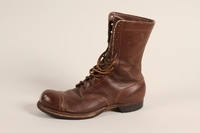
Pair of US Army paratrooper boots worn by a soldier
Object
Paratrooper boots issued to J. George Mitnick by the United States Army during World War II. Mitnick, a 27 year-old Jewish American, served as a captain in the 65th Infantry Division, European Theater. His unit took control of the Ohrdruf concentration camp in April 1945; nearly all the inhabitants were dead, killed by the departing German troops. This was the first concentration camp liberated by US troops and descriptions of the conditions horrified the world. Mitnick’s unit continued on into Austria and was involved with the liberation of Mauthausen concentration camp. Captain Mitnick was awarded two Bronze Stars for his service.
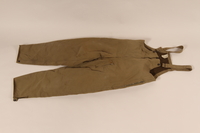
US Army khaki winter overalls worn by a soldier
Object
Khaki overalls issued to J. George Mitnick by the United States Army during World War II. Mitnick, a 27 year-old Jewish American, served as a captain in the 65th Infantry Division, European Theater. His unit took control of the Ohrdruf concentration camp in April 1945; nearly all the inhabitants were dead, killed by the departing German troops. This was the first concentration camp liberated by US troops and descriptions of the conditions horrified the world. Mitnick’s unit continued on into Austria and was involved with the liberation of Mauthausen concentration camp. Captain Mitnick was awarded two Bronze Stars for his service.
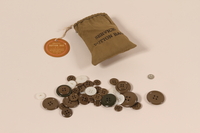
US Army drawstring button bag and buttons used by a soldier
Object
Button service bag issued to J. George Mitnick by the United States Army during World War II. Mitnick, a 27 year-old Jewish American, served as a captain in the 65th Infantry Division, European Theater. His unit took control of the Ohrdruf concentration camp in April 1945; nearly all the inhabitants were dead, killed by the departing German troops. This was the first concentration camp liberated by US troops and descriptions of the conditions horrified the world. Mitnick’s unit continued on into Austria and was involved with the liberation of Mauthausen concentration camp. Captain Mitnick was awarded two Bronze Stars for his service.
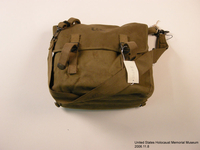
US Army canvas first aid bag used by a soldier
Object
First aid kit issued to J. George Mitnick by the United States Army during World War II. Mitnick, a 27 year-old, Jewish American, served as a captain in the 65th Infantry Division, European Theater. His unit took control of the Ohrdruf concentration camp in April 1945; nearly all the inhabitants were dead, killed by the departing German troops. This was the first concentration camp liberated by US troops and descriptions of the conditions horrified the world. Mitnick’s unit continued on into Austria and was involved with the liberation of Mauthausen concentration camp. Captain Mitnick was awarded two Bronze Stars for his service.
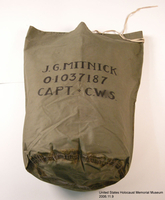
US Army duffel bag used by a soldier
Object
Duffel bag issued to J. George Mitnick by the United States Army during World War II. Mitnick, a 27 year-old Jewish American, served as a captain in the 65th Infantry Division, European Theater. His unit took control of the Ohrdruf concentration camp in April 1945; nearly all the inhabitants were dead, killed by the departing German troops. This was the first concentration camp liberated by US troops and descriptions of the conditions horrified the world. Mitnick’s unit continued on into Austria and was involved with the liberation of Mauthausen concentration camp. Captain Mitnick was awarded two Bronze Stars for his service.
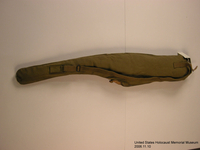
US Army M1 carbine weapon bag used by a soldier
Object
M1 weapon bag issued to J. George Mitnick by the United States Army during World War II. Mitnick, a 27 year-old, Jewish American, served as a captain in the 65th Infantry Division, European Theater. His unit took control of the Ohrdruf concentration camp in April 1945; nearly all the inhabitants were dead, killed by the departing German troops. This was the first concentration camp liberated by US troops and descriptions of the conditions horrified the world. Mitnick’s unit continued on into Austria and was involved with the liberation of Mauthausen concentration camp. Captain Mitnick was awarded two Bronze Stars for his service.
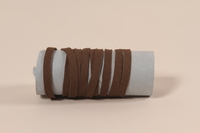
US Army issued brown shoelaces used by a soldier
Object
Shoelaces issued to J. George Mitnick by the United States Army during World War II. Mitnick, a 27 year-old Jewish American, served as a captain in the 65th Infantry Division, European Theater. His unit took control of the Ohrdruf concentration camp in April 1945; nearly all the inhabitants were dead, killed by the departing German troops. This was the first concentration camp liberated by US troops and descriptions of the conditions horrified the world. Mitnick’s unit continued on into Austria and was involved with the liberation of Mauthausen concentration camp. Captain Mitnick was awarded two Bronze Stars for his service.
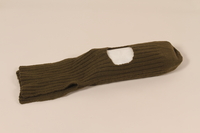
US Army olive drab knit balaclava used by a soldier
Object
Balaclava issued to J. George Mitnick by the United States Army during World War II. Mitnick, a 27 year-old Jewish American, served as a captain in the 65th Infantry Division, European Theater. His unit took control of the Ohrdruf concentration camp in April 1945; nearly all the inhabitants were dead, killed by the departing German troops. This was the first concentration camp liberated by US troops and descriptions of the conditions horrified the world. Mitnick’s unit continued on into Austria and was involved with the liberation of Mauthausen concentration camp. Captain Mitnick was awarded two Bronze Stars for his service.
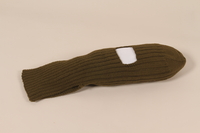
US Army olive drab knit balaclava used by a soldier
Object
Balaclava issued to J. George Mitnick by the United States Army during World War II. Mitnick, a 27 year-old Jewish American, served as a captain in the 65th Infantry Division, European Theater. His unit took control of the Ohrdruf concentration camp in April 1945; nearly all the inhabitants were dead, killed by the departing German troops. This was the first concentration camp liberated by US troops and descriptions of the conditions horrified the world. Mitnick’s unit continued on into Austria and was involved with the liberation of Mauthausen concentration camp. Captain Mitnick was awarded two Bronze Stars for his service.
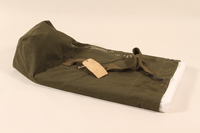
US Army duffel bag used by a soldier
Object
Duffel bag issued to J. George Mitnick by the United States Army during World War II. Mitnick, a 27 year-old Jewish American, served as a captain in the 65th Infantry Division, European Theater. His unit took control of the Ohrdruf concentration camp in April 1945; nearly all the inhabitants were dead, killed by the departing German troops. This was the first concentration camp liberated by US troops and descriptions of the conditions horrified the world. Mitnick’s unit continued on into Austria and was involved with the liberation of Mauthausen concentration camp. Captain Mitnick was awarded two Bronze Stars for his service.
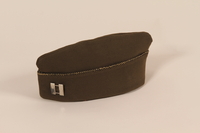
US Army garrison cap with piping and captain's insignia worn by a Jewish soldier
Object
Garrison cap with black and gold piping issued to J. George Mitnick by the United States Army during World War II. Mitnick, a 27 year-old Jewish American, served as a captain in the 65th Infantry Division, European Theater. His unit took control of the Ohrdruf concentration camp in April 1945; nearly all the inhabitants were dead, killed by the departing German troops. This was the first concentration camp liberated by US troops and descriptions of the conditions horrified the world. Mitnick’s unit continued on into Austria and was involved with the liberation of Mauthausen concentration camp. Captain Mitnick was awarded two Bronze Stars for his service.
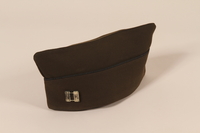
US Army garrison cap with black piping and captain's insignia worn by a Jewish soldier
Object
Garrison cap with black piping issued to J. George Mitnick by the United States Army during World War II. Mitnick, a 27 year-old, Jewish American, served as a captain in the 65th Infantry Division, European Theater. His unit took control of the Ohrdruf concentration camp in April 1945; nearly all the inhabitants were dead, killed by the departing German troops. This was the first concentration camp liberated by US troops and descriptions of the conditions horrified the world. Mitnick’s unit continued on into Austria and was involved with the liberation of Mauthausen concentration camp. Captain Mitnick was awarded two Bronze Stars for his service.
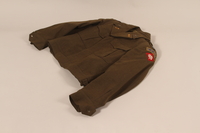
US Army captain's Eisenhower jacket worn by a soldier
Object
Jacket issued to J. George Mitnick by the United States Army during World War II. Mitnick, a 27 year-old Jewish American, served as a captain in the 65th Infantry Division, European Theater. His unit took control of the Ohrdruf concentration camp in April 1945; nearly all the inhabitants were dead, killed by the departing German troops. This was the first concentration camp liberated by US troops and descriptions of the conditions horrified the world. Mitnick’s unit continued on into Austria and was involved with the liberation of Mauthausen concentration camp. Captain Mitnick was awarded two Bronze Stars for his service.
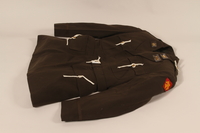
US Army captain's dress jacket worn by a soldier
Object
Jacket issued to J. George Mitnick by the United States Army during World War II. Mitnick, a 27 year-old Jewish American, served as a captain in the 65th Infantry Division, European Theater. His unit took control of the Ohrdruf concentration camp in April 1945; nearly all the inhabitants were dead, killed by the departing German troops. This was the first concentration camp liberated by US troops and descriptions of the conditions horrified the world. Mitnick’s unit continued on into Austria and was involved with the liberation of Mauthausen concentration camp. Captain Mitnick was awarded two Bronze Stars for his service.
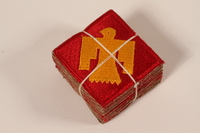
US Army, 45th Infantry Division, bundle of Class A Thunderbird patches
Object
Bundle of patches issued by the United States Army to J. George Mitnick during WWII. They appear to be unused. The Thunderbird division adopted this Native American symbol in 1939 to replace the previous symbol. a swastika. Mitnick, a 27 year-old Jewish American, served as a captain in the 65th Infantry Division, European Theater and in the Chemical Warfare Service, 91st Chemical Mortar Battalion, 45th Infantry Division. His unit took control of the Ohrdruf concentration camp in April 1945; nearly all the inhabitants were dead, killed by the departing German troops. This was the first concentration camp liberated by US troops and descriptions of the conditions horrified the world. Mitnick’s unit continued on into Austria and was involved with the liberation of Mauthausen concentration camp. Captain Mitnick was awarded two Bronze Stars for his service.
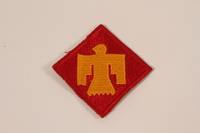
US Army, 45th Infantry Division, Class A Thunderbird patch issued to a Jewish soldier
Object
Red patch with an embroidered yellow Thunderbird issued to J. George Mitnick when he served in the 45th Infantry, US Army, during WWII. The Thunderbird division adopted this Native American symbol in 1939 to replace the previous symbol, a swastika. Mitnick, a 27 year-old Jewish American, served as a captain in the 65th Infantry Division, European Theater and in the Chemical Warfare Service, 91st Chemical Mortar Battalion, 45th Infantry Division. His unit took control of the Ohrdruf concentration camp in April 1945; nearly all the inhabitants were dead, killed by the departing German troops. This was the first concentration camp liberated by US troops and descriptions of the conditions horrified the world. Mitnick’s unit continued on into Austria and was involved with the liberation of Mauthausen concentration camp. Captain Mitnick was awarded two Bronze Stars for his service.
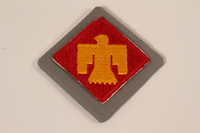
US Army, 45th Infantry Division, Class A Thunderbird patch issued to a Jewish soldier
Object
Red patch with an embroidered yellow Thunderbird issued to J. George Mitnick when he served in the 45th Infantry, US Army, during WWII. The Thunderbird division adopted this Native American symbol in 1939 to replace the previous symbol. a swastika. Mitnick, a 27 year-old Jewish American, served as a captain in the 65th Infantry Division, European Theater and in the Chemical Warfare Service, 91st Chemical Mortar Battalion, 45th Infantry Division. His unit took control of the Ohrdruf concentration camp in April 1945; nearly all the inhabitants were dead, killed by the departing German troops. This was the first concentration camp liberated by US troops and descriptions of the conditions horrified the world. Mitnick’s unit continued on into Austria and was involved with the liberation of Mauthausen concentration camp. Captain Mitnick was awarded two Bronze Stars for his service.
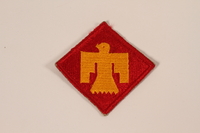
US Army, 45th Infantry Division, Class A Thunderbird patch issued to a Jewish soldier
Object
Unused red patch with an embroidered yellow Thunderbird issued to J. George Mitnick when he served in the 45th Infantry, US Army, during WWII. The Thunderbird division adopted this Native American symbol in 1939 to replace the previous symbol. a swastika. Mitnick, a 27 year-old Jewish American, served as a captain in the 65th Infantry Division, European Theater and in the Chemical Warfare Service, 91st Chemical Mortar Battalion, 45th Infantry Division. His unit took control of the Ohrdruf concentration camp in April 1945; nearly all the inhabitants were dead, killed by the departing German troops. This was the first concentration camp liberated by US troops and descriptions of the conditions horrified the world. Mitnick’s unit continued on into Austria and was involved with the liberation of Mauthausen concentration camp. Captain Mitnick was awarded two Bronze Stars for his service.
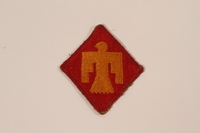
US Army, 45th Infantry Division, Class A Thunderbird patch owned by a Jewish soldier
Object
Unused red patch with an embroidered yellow Thunderbird issued to J. George Mitnick when he served in the 45th Infantry, US Army, during WWII. The Thunderbird division adopted this Native American symbol in 1939 to replace the previous symbol. a swastika. Mitnick, a 27 year-old Jewish American, served as a captain in the 65th Infantry Division, European Theater and in the Chemical Warfare Service, 91st Chemical Mortar Battalion, 45th Infantry Division. His unit took control of the Ohrdruf concentration camp in April 1945; nearly all the inhabitants were dead, killed by the departing German troops. This was the first concentration camp liberated by US troops and descriptions of the conditions horrified the world. Mitnick’s unit continued on into Austria and was involved with the liberation of Mauthausen concentration camp. Captain Mitnick was awarded two Bronze Stars for his service.

US Army 2nd Lieutenant subdued marking patch issued to a Jewish soldier
Object
US Army 2nd Lieutenant patch issued to J. George Mitnick when he served in the US Army during WWII. Mitnick, a 27 year-old Jewish American, served as a captain in the 65th Infantry Division, European Theater and in the Chemical Warfare Service, 91st Chemical Mortar Battalion, 45th Infantry Division. His unit took control of the Ohrdruf concentration camp in April 1945; nearly all the inhabitants were dead, killed by the departing German troops. This was the first concentration camp liberated by US troops and descriptions of the conditions horrified the world. Mitnick’s unit continued on into Austria and was involved with the liberation of Mauthausen concentration camp. Captain Mitnick was awarded two Bronze Stars for his service.
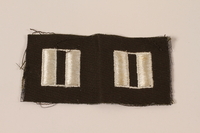
US Army captain's insignia patch worn by a Jewish soldier
Object
US Army captain’s insignia issued to J. George Mitnick when he served in the United States Army during World War II. Mitnick, a 27 year-old Jewish American, served as a captain in the 65th Infantry Division, European Theater and in the Chemical Warfare Service, 91st Chemical Mortar Battalion, 45th Infantry Division. His unit took control of the Ohrdruf concentration camp in April 1945; nearly all the inhabitants were dead, killed by the departing German troops. This was the first concentration camp liberated by US troops and descriptions of the conditions horrified the world. Mitnick’s unit continued on into Austria and was involved with the liberation of Mauthausen concentration camp. Captain Mitnick was awarded two Bronze Stars for his service.
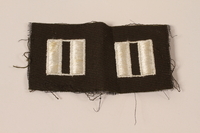
US Army captain's insignia patch worn by a Jewish soldier
Object
US Army captain’s insignia issued to J. George Mitnick when he served in the United States Army during World War II. Mitnick, a 27 year-old Jewish American, served as a captain in the 65th Infantry Division, European Theater and in the Chemical Warfare Service, 91st Chemical Mortar Battalion, 45th Infantry Division. His unit took control of the Ohrdruf concentration camp in April 1945; nearly all the inhabitants were dead, killed by the departing German troops. This was the first concentration camp liberated by US troops and descriptions of the conditions horrified the world. Mitnick’s unit continued on into Austria and was involved with the liberation of Mauthausen concentration camp. Captain Mitnick was awarded two Bronze Stars for his service.
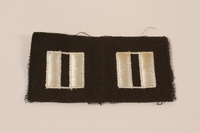
US Army captain's insignia patch worn by a Jewish soldier
Object
US Army captain’s insignia issued to J. George Mitnick when he served in the United States Army during World War II. Mitnick, a 27 year-old Jewish American, served as a captain in the 65th Infantry Division, European Theater and in the Chemical Warfare Service, 91st Chemical Mortar Battalion, 45th Infantry Division. His unit took control of the Ohrdruf concentration camp in April 1945; nearly all the inhabitants were dead, killed by the departing German troops. This was the first concentration camp liberated by US troops and descriptions of the conditions horrified the world. Mitnick’s unit continued on into Austria and was involved with the liberation of Mauthausen concentration camp. Captain Mitnick was awarded two Bronze Stars for his service.

US Army captain's insignia patch worn by a Jewish soldier
Object
US Army captain’s insignia issued to J. George Mitnick when he served in the United States Army during World War II. Mitnick, a 27 year-old Jewish American, served as a captain in the 65th Infantry Division, European Theater and in the Chemical Warfare Service, 91st Chemical Mortar Battalion, 45th Infantry Division. His unit took control of the Ohrdruf concentration camp in April 1945; nearly all the inhabitants were dead, killed by the departing German troops. This was the first concentration camp liberated by US troops and descriptions of the conditions horrified the world. Mitnick’s unit continued on into Austria and was involved with the liberation of Mauthausen concentration camp. Captain Mitnick was awarded two Bronze Stars for his service.
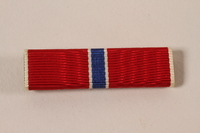
US Army Bronze Star ribbon bar pin awarded to a Jewish soldier
Object
Bronze Star awarded to J. George Mitnick by the United States Army after World War II. Mitnick, a 27 year-old Jewish American, served as a captain in the 65th Infantry Division, European Theater and in the Chemical Warfare Service, 91st Chemical Mortar Battalion, 45th Infantry Division. His unit took control of the Ohrdruf concentration camp in April 1945; nearly all the inhabitants were dead, killed by the departing German troops. This was the first concentration camp liberated by US troops and descriptions of the conditions horrified the world. Mitnick’s unit continued on into Austria and was involved with the liberation of Mauthausen concentration camp. Captain Mitnick was awarded two Bronze Stars for his service.
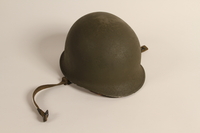
US Army M1 combat helmet worn by a Jewish soldier
Object
Combat helmet issued to J. George Mitnick by the United States Army during World War II. Mitnick, a 27 year-old Jewish American, served as a captain in the 65th Infantry Division, European Theater and in the Chemical Warfare Service, 91st Chemical Mortar Battalion, 45th Infantry Division. His unit took control of the Ohrdruf concentration camp in April 1945; nearly all the inhabitants were dead, killed by the departing German troops. This was the first concentration camp liberated by US troops and descriptions of the conditions horrified the world. Mitnick’s unit continued on into Austria and was involved with the liberation of Mauthausen concentration camp. Captain Mitnick was awarded two Bronze Stars for his service.
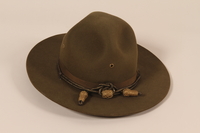
US Army service hat and hat box owned by a Jewish soldier
Object
Service hat issued to J. George Mitnick by the United States Army during World War II. Service hats were issued to both officers and enlisted men. The color of the cord around the brim indicated the enlisted man’s branch of service. Service hats with the gold and black cords were issued to officers. Mitnick, a 27 year-old Jewish American, served as a captain in the 65th Infantry Division, European Theater and in the Chemical Warfare Service, 91st Chemical Mortar Battalion, 45th Infantry Division. His unit took control of the Ohrdruf concentration camp in April 1945; nearly all the inhabitants were dead, killed by the departing German troops. This was the first concentration camp liberated by US troops and descriptions of the conditions horrified the world. Mitnick’s unit continued on into Austria and was involved with the liberation of Mauthausen concentration camp. Captain Mitnick was awarded two Bronze Stars for his service.
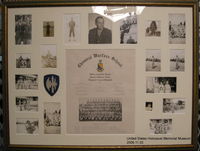
Framed certificate and pictures of J. George Mitnick in uniform
Object
Photographic collage of J. George Mitnick with images from his service in the United States Army during World War II. Mitnick, a 27 year-old Jewish American, served as a captain in the 65th Infantry Division, European Theater and in the Chemical Warfare Service, 91st Chemical Mortar Battalion, 45th Infantry Division. His unit took control of the Ohrdruf concentration camp in April 1945; nearly all the inhabitants were dead, killed by the departing German troops. This was the first concentration camp liberated by US troops and descriptions of the conditions horrified the world. Mitnick’s unit continued on into Austria and was involved with the liberation of Mauthausen concentration camp. Captain Mitnick was awarded two Bronze Stars for his service.
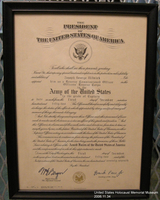
Framed officer's commission for the US Army Reserves
Object
Framed officer's commission issued to J. George Mitnick by the United States Army in 1952. Mitnick, a 27 year-old Jewish American, served as a captain in the 65th Infantry Division, European Theater and in the Chemical Warfare Service, 91st Chemical Mortar Battalion, 45th Infantry Division. His unit took control of the Ohrdruf concentration camp in April 1945; nearly all the inhabitants were dead, killed by the departing German troops. This was the first concentration camp liberated by US troops and descriptions of the conditions horrified the world. Mitnick’s unit continued on into Austria and was involved with the liberation of Mauthausen concentration camp. Captain Mitnick was awarded two Bronze Stars for his service.
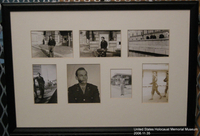
Photographic collage of J. George Mitnick in uniform
Object
Framed set of pictures of J. George Mitnick during his service in the United States Army during World War II. Mitnick, a 27 year-old Jewish American, served as a captain in the 65th Infantry Division, European Theater and in the Chemical Warfare Service, 91st Chemical Mortar Battalion, 45th Infantry Division. His unit took control of the Ohrdruf concentration camp in April 1945; nearly all the inhabitants were dead, killed by the departing German troops. This was the first concentration camp liberated by US troops and descriptions of the conditions horrified the world. Mitnick’s unit continued on into Austria and was involved with the liberation of Mauthausen concentration camp. Captain Mitnick was awarded two Bronze Stars for his service.
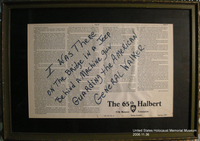
Framed annotated article from the 65th Halbert newsletter saved by a US soldier
Object
Article from The 65th Halbert newsletter, Spring 1987, p. 25 and 26, with handwritten statement: I was there on the bridge in a jeep behind a machine gun guarding the American General Walker. The article discusses an event from WWII in which J. George Mitnick participated while serving in Europe with the US Army. Mitnick, a 27 year-old Jewish American, served as a captain in the 65th Infantry Division, European Theater and in the Chemical Warfare Service, 91st Chemical Mortar Battalion, 45th Infantry Division. His unit took control of the Ohrdruf concentration camp in April 1945; nearly all the inhabitants were dead, killed by the departing German troops. This was the first concentration camp liberated by US troops and descriptions of the conditions horrified the world. Mitnick’s unit continued on into Austria and was involved with the liberation of Mauthausen concentration camp. Captain Mitnick was awarded two Bronze Stars for his service.
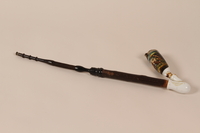
German ceramic pipe with a painted scene of two deer
Object
German pipe acquired in Europe during World War II by J. George Mitnick. Mitnick, a 27 year-old Jewish American, served as a captain in the 65th Infantry Division, European Theater and in the Chemical Warfare Service, 91st Chemical Mortar Battalion, 45th Infantry Division. His unit took control of the Ohrdruf concentration camp in April 1945; nearly all the inhabitants were dead, killed by the departing German troops. This was the first concentration camp liberated by US troops and descriptions of the conditions horrified the world. Mitnick’s unit continued on into Austria and was involved with the liberation of Mauthausen concentration camp. Captain Mitnick was awarded two Bronze Stars for his service.
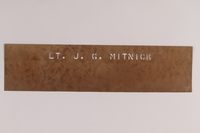
Lt. J. George Mitnick stencil used to label his US Army equipment
Object
LT. J. G. MITNICK Stencil used to apply Mitnick’s name to the equipment issued by the United States Army to J. George Mitnick during WWII. Mitnick, a 27 year-old Jewish American, served as a captain in the 65th Infantry Division, European Theater and in the Chemical Warfare Service, 91st Chemical Mortar Battalion, 45th Infantry Division. His unit took control of the Ohrdruf concentration camp in April 1945; nearly all the inhabitants were dead, killed by the departing German troops. This was the first concentration camp liberated by US troops and descriptions of the conditions horrified the world. Mitnick’s unit continued on into Austria and was involved with the liberation of Mauthausen concentration camp. Captain Mitnick was awarded two Bronze Stars for his service.
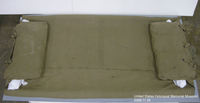
US Army olive drab canvas bed roll used by a soldier
Object
Bedroll issued to J. George Mitnick by the United States Army during World War II. Mitnick, a 27 year-old Jewish American, served as a captain in the 65th Infantry Division, European Theater and in the Chemical Warfare Service, 91st Chemical Mortar Battalion, 45th Infantry Division. His unit took control of the Ohrdruf concentration camp in April 1945; nearly all the inhabitants were dead, killed by the departing German troops. This was the first concentration camp liberated by US troops and descriptions of the conditions horrified the world. Mitnick’s unit continued on into Austria and was involved with the liberation of Mauthausen concentration camp. Captain Mitnick was awarded two Bronze Stars for his service.
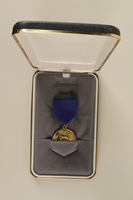
Republican Senatorial Medal of Freedom and presentation case awarded to J. George Mitnick
Object
Medal awarded to J. George Mitnick after WWII for a lifetime of service to his community and country. Mitnick, a 27 year-old Jewish American, served as a captain in the 65th Infantry Division, European Theater and in the Chemical Warfare Service, 91st Chemical Mortar Battalion, 45th Infantry Division. His unit took control of the Ohrdruf concentration camp in April 1945; nearly all the inhabitants were dead, killed by the departing German troops. This was the first concentration camp liberated by US troops and descriptions of the conditions horrified the world. Mitnick’s unit continued on into Austria and was involved with the liberation of Mauthausen concentration camp. Captain Mitnick was awarded two Bronze Stars for his service.
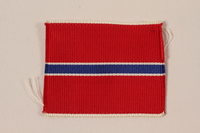
US Army Bronze Star ribbon awarded to Captain J.G. Mitnick
Object
Bronze star ribbon awarded to George Mitnick by the United States Army for his service in World War II. Mitnick, a 27 year-old Jewish American, served as a captain in the 65th Infantry Division, European Theater and in the Chemical Warfare Service, 91st Chemical Mortar Battalion, 45th Infantry Division. His unit took control of the Ohrdruf concentration camp in April 1945; nearly all the inhabitants were dead, killed by the departing German troops. This was the first concentration camp liberated by US troops and descriptions of the conditions horrified the world. Mitnick’s unit continued on into Austria and was involved with the liberation of Mauthausen concentration camp. Captain Mitnick was awarded two Bronze Stars for his service.
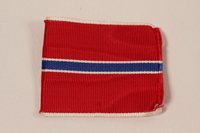
US Army Bronze Star ribbon awarded to Captain J.G. Mitnick
Object
Bronze star ribbon awarded to George Mitnick by the United States Army for his service in World War II. Mitnick, a 27 year-old Jewish American, served as a captain in the 65th Infantry Division, European Theater and in the Chemical Warfare Service, 91st Chemical Mortar Battalion, 45th Infantry Division. His unit took control of the Ohrdruf concentration camp in April 1945; nearly all the inhabitants were dead, killed by the departing German troops. This was the first concentration camp liberated by US troops and descriptions of the conditions horrified the world. Mitnick’s unit continued on into Austria and was involved with the liberation of Mauthausen concentration camp. Captain Mitnick was awarded two Bronze Stars for his service.
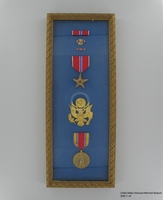
Framed set of military medals, ribbons, and insignia awarded to US Army Captain J.G. Mitnick
Object
Framed set of awards issued to J. George Mitnick by the United States Army for his service in World War II. Mitnick, a 27 year-old Jewish American, served as a captain in the 65th Infantry Division, European Theater and in the Chemical Warfare Service, 91st Chemical Mortar Battalion, 45th Infantry Division. His unit took control of the Ohrdruf concentration camp in April 1945; nearly all the inhabitants were dead, killed by the departing German troops. This was the first concentration camp liberated by US troops and descriptions of the conditions horrified the world. Mitnick’s unit continued on into Austria and was involved with the liberation of Mauthausen concentration camp. Captain Mitnick was awarded two Bronze Stars for his service.
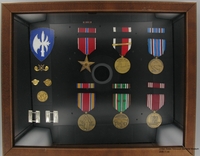
Framed shadow box of military medals and ribbons awarded to a US Army Captain
Object
Framed shadow box of awards issued to J. George Mitnick by the United States Army. Mitnick, a 27 year-old Jewish American, served as a captain in the 65th Infantry Division, European Theater and in the Chemical Warfare Service, 91st Chemical Mortar Battalion, 45th Infantry Division. His unit took control of the Ohrdruf concentration camp in April 1945. Nearly all the inhabitants were dead, killed by the departing German troops. This was the first concentration camp liberated by US troops and descriptions of the conditions horrified the world. Mitnick’s unit continued on into Austria and was involved with the liberation of Mauthausen concentration camp. Captain Mitnick was awarded two Bronze Stars for his service.
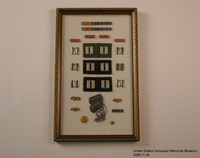
Framed set of military medals, ribbons and insignia awarded to US Army Captain J.G. Mitnick
Object
Framed set of awards issued to J. George Mitnick by the United States Army for his service in World War II. Mitnick, a 27 year-old Jewish American, served as a captain in the 65th Infantry Division, European Theater and in the Chemical Warfare Service, 91st Chemical Mortar Battalion, 45th Infantry Division. His unit took control of the Ohrdruf concentration camp in April 1945; nearly all the inhabitants were dead, killed by the departing German troops. This was the first concentration camp liberated by US troops and descriptions of the conditions horrified the world. Mitnick’s unit continued on into Austria and was involved with the liberation of Mauthausen concentration camp. Captain Mitnick was awarded two Bronze Stars for his service.
Stars and Stripes issue
Document
Contains a copy of the "Stars and Stripes" newspaper, dated March 19, 1945.

